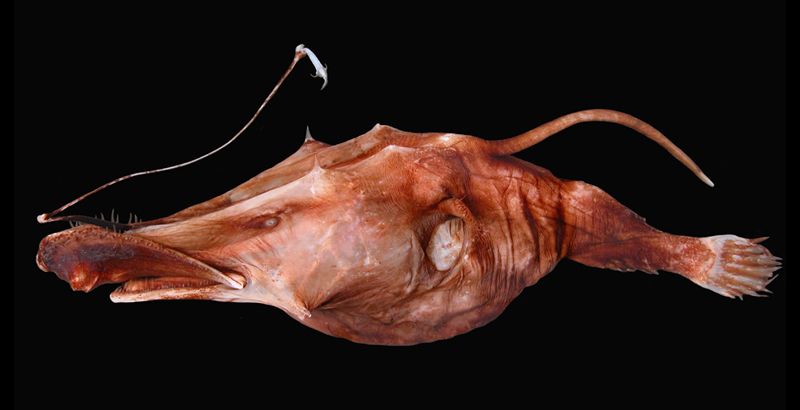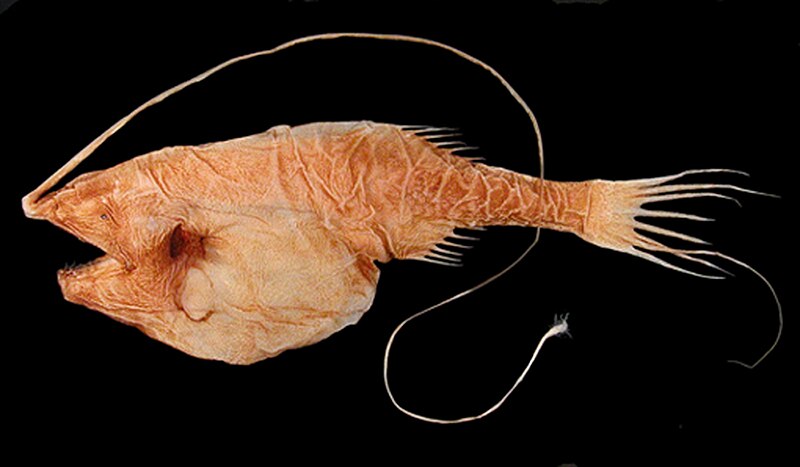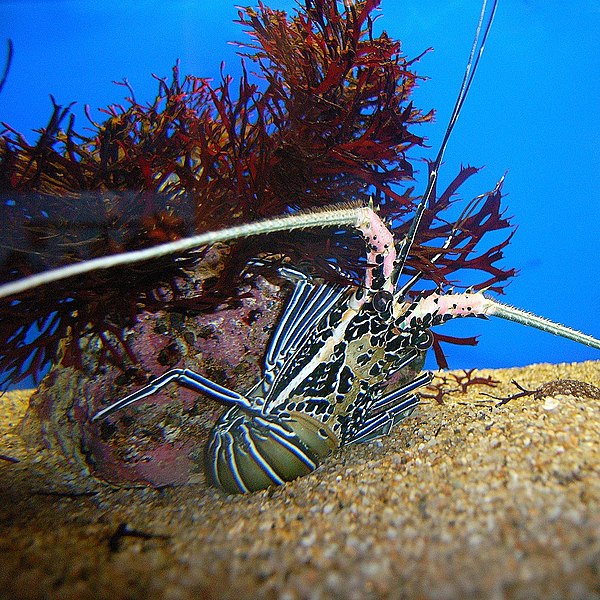The Freaks and the Beauties of the Deep-Sea
I entitled this article “The Freaks and Beauties of the Deep-Sea” because some of the creatures included here may be considered by others as “freaks” while others may view them as “beauties”. Well, it is a fact that people view things differently – so we have to consider most of the time the so-called “individual differences ”.
”.
1.) Pelican Eel (Eurypharynx pelecanoides)
The odd-looking Pelican Eel is a rarely seen deep-sea fish. It was named Pelican Eel; due to its elongated body that resembles an eel and its enormous mouth which is larger than its body that resembles that of a Pelican. The mouth is loosely-hinged, and can be opened wide enough to swallow a fish much larger than itself. The stomach can stretch and expand to accommodate large meals. It is also commonly known as Umbrella  Mouth Gulper.
Mouth Gulper.
2.) Mirror Belly (Opisthoproctus grimaldii)
The bizarre-looking Mirrorbelly is a deep-sea barreleye fish that inhabits deep tropical and subtropical oceans of the world at depths of 2,000 meters. Mirrorbellies can grow up to 8 cm in length. This freak-looking fish is also commonly known as Barreleye.
fish that inhabits deep tropical and subtropical oceans of the world at depths of 2,000 meters. Mirrorbellies can grow up to 8 cm in length. This freak-looking fish is also commonly known as Barreleye.
3.) Flashlight Fish (Photostomias guernei)
Many deep-sea animals are bioluminescent like the Flashlight Fish. This weird-looking deep-sea fish has a built-in bioluminescent “flashlight” it uses to help it see in the dark. The light is used to attract prey, and for communication. Flashlight Fishes have adapted in creating their own light because of the deepness of where they live, sunlight cannot penetrate it. Flashlight Fish can be found in all tropical waters of the world and can grow up to 28 cm in length.
it uses to help it see in the dark. The light is used to attract prey, and for communication. Flashlight Fishes have adapted in creating their own light because of the deepness of where they live, sunlight cannot penetrate it. Flashlight Fish can be found in all tropical waters of the world and can grow up to 28 cm in length.
4.) Hairy Angler (Caulophryne polynema)
The Hairy Angler is a certified freak of the deep-sea. Of course we all know that fishes don’t have hair but the Hairy Angler does. The female of this species, which is 10 time much bigger than the male, can grow as big as a football. It can consume large fish bigger than itself because it has an expandable stomach. It inhabits the dark zone of the ocean which is more than 1,000 meters deep from the ocean’s surface.
stomach. It inhabits the dark zone of the ocean which is more than 1,000 meters deep from the ocean’s surface.
5.) Deep-sea Anglerfish (Lasiognathus amphirhamphus)
One of the freakiest and weirdest deep-sea creatures is the Lasiognathus amphirhamphus. This deep-sea anglerfish is distinctive not only for its angler but also for its huge upper jaw which is much larger than its lower jaw. It also has a unique tail-like object on its back. The scales body is also bizarre in shape and appearance.
6.) Half-naked Hatchetfish (Argyropelecus hemigymnus)
There are several species of hatchetfish but the freakiest is the Half-naked Hatchetfish. This deep-sea hatchetfish can be found in deep tropical and subtropical waters of all the oceans in the world. It can grow up to 5 centimeter in size. It is also commonly known as Spurred Hatchet fish or Short Silver Hatchetfish.
fish or Short Silver Hatchetfish.
7.) Football Fish (Himantolophus sp)
The unusual-looking and globose in shape Football Fish is a deep-sea anglerfish that can be found in tropical and subtropical waters of the world. Like all other anglerfish, the female Football  Fish, which can grow up to more than 60 cm, is much larger than the male. Both male and female are reddish to black in color.
Fish, which can grow up to more than 60 cm, is much larger than the male. Both male and female are reddish to black in color.
8.) Gigantactis
This unique-looking deep-sea creature that belongs to the genus Gigantactis can be found in all oceans of the world at depths of 1,000 to 2,500 m. The most striking feature of these fish is its illicium which is an extremely enlarged first filament of dorsal fin with bioluminescent photopore at its end.
photopore at its end.
9.) Sabertooth Fish (Coccorella atrata)
Sabertooth Fishes are small, fierce-looking deep-sea fish that can be found in the tropical and subtropical waters of Atlantic, Indian and Pacific Ocean. There are 8 species of Sabertooth Fish and the most notable is Coccorella atrata.
Fish and the most notable is Coccorella atrata.
10.) Patagonian Toothfish (Dissostichus eleginoides)
The Patagonian Toothfish is an edible fish found in the cold, temperate waters of Atlantic, Pacific and Southern Ocean at depths of up to 3,850 meters. This large fish can attain a weight of up to 200 kg and can grow to a length of up to 2.7 meters and has a lifespan of 50 years. It is also commonly known as Chile an Sea Bass.
an Sea Bass.
11.) Roughback Batfish (Ogcocephalus parvus)
This bottom-dwelling animal doesn’t look like a fish at all. In fairness, this peculiar-looking fish has lovable and kissable red lips. Commonly known as the Roughback Batfish, this unusual creature can be found in subtropical waters of the Atlantic Ocean.
Commonly known as the Roughback Batfish, this unusual creature can be found in subtropical waters of the Atlantic Ocean.
12.) Lovely Hatchetfish (Argyropelecus aculeatus)
The common name of the Lovely Hatchetfish is truly lovely but somehow it still looks peculiar in appearance. This unusual-looking fish is also commonly known as Atlantic Silver Hatchetfish. It belongs to Sternoptychidae family.
Hatchetfish. It belongs to Sternoptychidae family.
13.) Striated Frogfish (Antennarius striatus)
The odd-looking Striated Frogfish is a deep-sea fish that lives as deep as 210 meters below the ocean’s surface. This bizarre fish, which is covered with hair-like things, can be found in subtropical waters of all the oceans in the world. It can grow up to 25 cm in length.
14.) False Catshark (Pseudotriakis microdon)
The False Catshark is a large ground shark species that inhabits oceans of the world at depths of up to 1,500 meters. It is a slow-moving shark that feeds on bony fishes .
.
15.) Seven-Arm Octopus (Haliphron atlanticus)
The Seven-arm Octopus is a very large octopus that can attain a length of 4 meters and can weigh up to 75 kg. It is the world’s largest known species of octopus. The Seven-arm Octopus is so named because in males the hectocotylus is coiled in a sac beneath the right eye. Due to this species' thick gelatinous tissue, the arm is easily overlooked, giving the appearance of just seven arms. However, like other octopuses, it actually has eight.





























